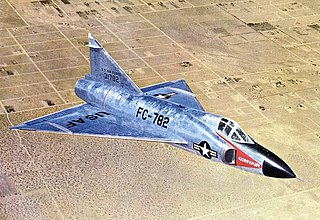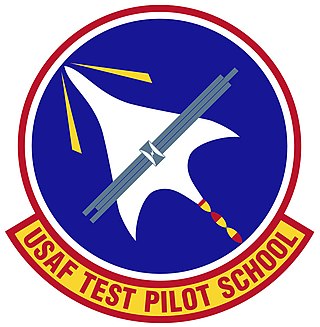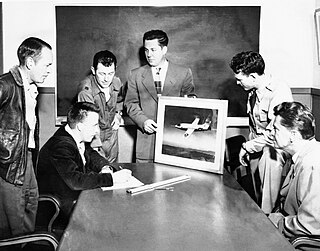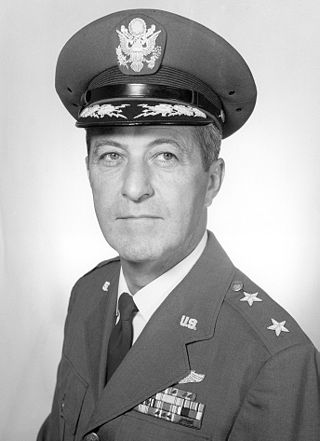
Strategic Air Command is a 1955 American military aviation film starring James Stewart and June Allyson, directed by Anthony Mann, and released by Paramount Pictures. It was the first of four Hollywood films that depicted the role of the Strategic Air Command in the Cold War era.

Edwards Air Force Base (AFB) is a United States Air Force installation in California. Most of the base sits in Kern County, but its eastern end is in San Bernardino County and a southern arm is in Los Angeles County. The hub of the base is Edwards, California. Established in the 1930s as Muroc Field, the facility was renamed Muroc Army Airfield and then Muroc Air Force Base before its final renaming in 1950 for World War II USAAF veteran and test pilot Capt. Glen Edwards.

The Convair F-106 Delta Dart was an all-weather interceptor aircraft designed and produced by the American aircraft manufacturer Convair.

The Republic XF-91 Thunderceptor is a mixed-propulsion prototype interceptor aircraft, developed by Republic Aviation. The aircraft would use a jet engine for most flight, and a cluster of four small rocket engines for added thrust during climb and interception. The design was largely obsolete by the time it was completed due to the rapidly increasing performance of contemporary jet engines, and only two prototypes were built. One of these was the first American fighter to exceed Mach 1 in level flight.

The Convair F-102 Delta Dagger was an interceptor aircraft designed and produced by the American aircraft manufacturer Convair. A member of the Century Series, the F-102 was the first operational supersonic interceptor and delta-wing fighter operated by the United States Air Force (USAF).

The McDonnell XF-85 Goblin is an American prototype fighter aircraft conceived during World War II by McDonnell Aircraft. It was intended to deploy from the bomb bay of the Convair B-36 bomber as a parasite fighter. The XF-85's intended role was to defend bombers from hostile interceptor aircraft, a need demonstrated during World War II. McDonnell built two prototypes before the Air Force (USAAF) terminated the program.

The Convair B-58 Hustler, designed and produced by American aircraft manufacturer Convair, was the first operational bomber capable of Mach 2 flight.

Charles Gordon Fullerton was a United States Air Force colonel, a USAF and NASA astronaut, and a research pilot at NASA's Dryden Flight Research Facility, Edwards, California. His assignments included a variety of flight research and support activities piloting NASA's B-52 launch aircraft, the Boeing 747 Shuttle Carrier Aircraft (SCA), and other multi-engine and high performance aircraft.

The U.S. Air Force Test Pilot School is the Air Force's advanced flight training school that trains experimental test pilots, flight test engineers, and flight test navigators to carry out tests and evaluations of new aerospace weapon systems and also other aircraft of the U.S. Air Force. This school was established on 9 September 1944 as the Flight Test Training Unit at Wright-Patterson Air Force Base (AFB) in Dayton, Ohio. To take advantage of the uncongested skies, usually superb flying weather, and the lack of developed zones in the event of crashing, the test pilot school was officially moved to its present location at Edwards Air Force Base in the Mojave Desert of Southern California on 4 February 1951.

The Convair XF-92 was an American, delta wing, first-generation jet prototype. Originally conceived as a point-defence interceptor, the design was later used purely for experimental purposes and only one was built. However, it led Convair to use the delta-wing on a number of designs, including the F-102 Delta Dagger, F-106 Delta Dart, B-58 Hustler, the US Navy's F2Y Sea Dart as well as the VTOL FY Pogo.

Brigadier General Frank Kendall "Pete" Everest Jr. was a U.S. Air Force officer who is best remembered as an aeroengineer and test pilot during the 1950s.

The FICON program was conducted by the United States Air Force in the 1950s to test the feasibility of a Convair B-36 Peacemaker bomber carrying a Republic F-84 Thunderflash parasite fighter in its bomb bay. Earlier wingtip coupling experiments included Tip Tow, which were attempts at carrying fighters connected to the wingtips of bombers. Tom-Tom followed the FICON project afterwards.

Colonel Jackie Lynwood Ridley was an aeronautical engineer, USAF test pilot and chief of the U.S. Air Force's Flight Test Engineering Laboratory. He helped develop and test many Cold War era military aircraft. He worked on the Bell X-1, the first aircraft to achieve supersonic flight, and was highly respected among fellow test pilots, most notably Chuck Yeager, for his engineering skills.

The Republic XF-84H "Thunderscreech" was an American experimental turboprop aircraft derived from the F-84F Thunderstreak. Powered by a turbine engine that was mated to a supersonic propeller, the XF-84H had the potential of setting the unofficial air speed record for propeller-driven aircraft, but was unable to overcome aerodynamic deficiencies and engine reliability problems, resulting in the program's cancellation. Its name, Thunderscreech, is a reference to its extremely loud supersonic propeller.

The 412th Test Wing is a wing of the United States Air Force, assigned to the Air Force Test Center at Edwards Air Force Base, California.

Lieutenant General Ted Francis Bowlds is a former Commander, Electronic Systems Center, Hanscom Air Force Base, Mass. The center's mission is to acquire command and control systems for the Air Force. The organization comprises more than 12,000 people located at six sites throughout the United States. The men and women of the ESC manage more than $3 billion in programs annually in support of the Air Force, and joint and coalition forces.

Fred J. Ascani was an American major general and test pilot of the United States Air Force. He was one of the "Men of Mach 1" and was considered the father of systems engineering at Wright Field.

John L. "Jack" Hudson is a retired lieutenant general in the U.S. Air Force. He was Commander, Aeronautical Systems Center, Wright-Patterson Air Force Base, Ohio (WPAFB). Hudson also served as a member of the Senior Executive Service as the Director of the National Museum of the United States Air Force at WPAFB from 2009 to 2018.

Lieutenant General Clyde Dewey Moore II is a retired United States Air Force officer who served as Commander, Air Force Life Cycle Management Center, Wright-Patterson Air Force Base, Ohio. The organization is the single center responsible for total life cycle management covering all aircraft, engines, munitions, and electronic systems.

Robert M. Bond was a lieutenant general in the United States Air Force (USAF). He saw combat in Korea and three tours in Vietnam, before becoming an instructor and then vice-commander of an organization which developed and evaluated weaponry for the USAF. He was decorated for his combat service and his peacetime role. He died in an accident in Nevada while flying a Soviet-built Mikoyan-Gurevich MiG-23 jet fighter-bomber.





















